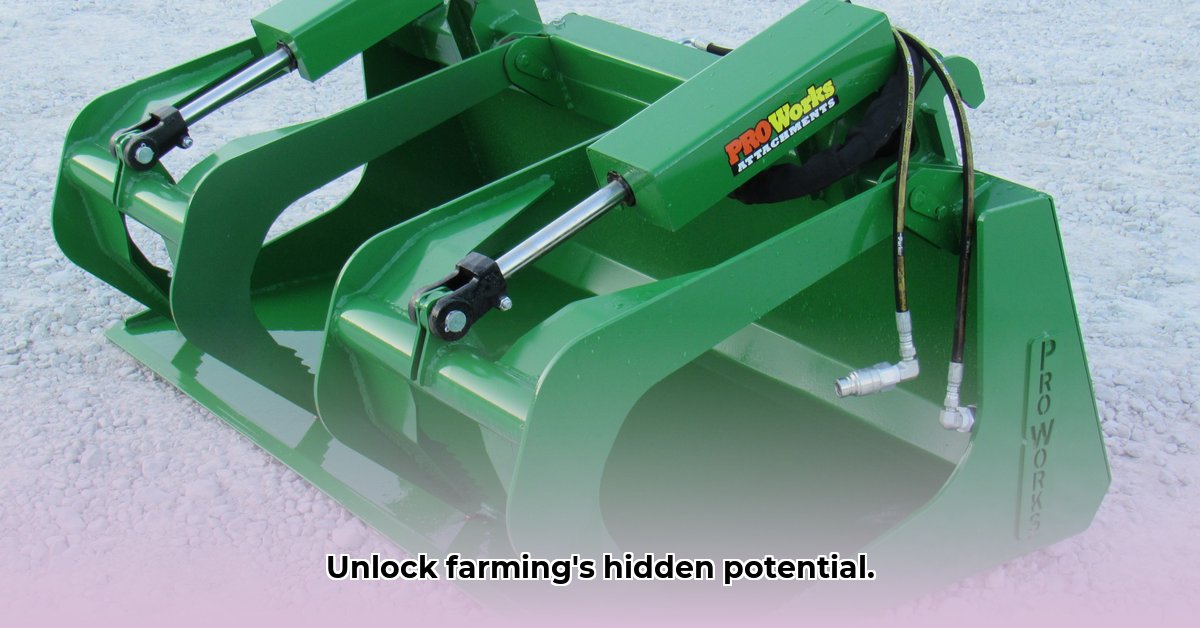
Farmers constantly seek ways to enhance efficiency and sustainability. The John Deere tractor grapple emerges as a powerful tool, revolutionizing material handling on farms and contributing to more environmentally conscious practices. This versatile attachment offers significant advantages, but careful consideration of its limitations is crucial for informed decision-making. For more options, check out these John Deere attachments.
Unleashing the Multifaceted Power of the John Deere Grapple
Beyond its traditional role in hay bale management, the John Deere grapple showcases remarkable versatility. Its applications extend to moving heavy pallets of feed, efficient brush clearing, and even post-storm debris removal. This adaptability makes it a valuable asset for diverse farming operations. How much time do you currently spend on manual material handling? A John Deere grapple significantly reduces this time, freeing resources for crucial farm tasks, directly impacting profitability.
Optimizing Your Choice: Selecting the Right John Deere Grapple
Choosing the appropriate grapple model is paramount to reaping its full benefits. John Deere provides a range of models, each tailored to specific needs and tractor compatibility. Key factors to consider include:
- Lifting Capacity: The grapple's capacity must match the weight of the heaviest materials it will handle. Underestimating this requirement can lead to operational limitations.
- Tine Spacing: The gap between the grapple's "fingers" influences its suitability for different materials. Narrow spacing is ideal for smaller items like brush, while wider spacing is better for larger items like hay bales.
- Tractor Compatibility: Ensure the grapple's compatibility with your tractor's hydraulic system and the tractor's sufficient power to operate it effectively.
Consider these example grapple models (note that models and specifications are subject to change; always consult official John Deere resources for the latest information):
| Grapple Model (Example) | Lifting Capacity (lbs) (Approximate) | Tine Spacing (inches) (Approximate) | Ideal Uses |
|---|---|---|---|
| JD100 | 1000 | 6-8 | Hay bales, light debris removal |
| JD200 | 2000 | 12-18 | Larger hay bales, heavier materials |
| JD300 | 3000 | 24-36 | Pallet handling, large debris, bulk material |
A Balanced Perspective: Weighing the Pros and Cons
While the John Deere grapple offers compelling advantages, a balanced assessment of potential drawbacks is essential.
Advantages:
- Enhanced Efficiency: Faster material handling translates to reduced labor costs and minimal downtime.
- Ergonomic Improvements: Reduced manual labor creates a safer and less physically demanding work environment.
- Exceptional Versatility: One grapple can handle diverse tasks, optimizing return on investment.
- Improved Safety: Minimizes risks associated with manually handling heavy materials.
Disadvantages:
- Significant Upfront Cost: The initial investment can be substantial.
- Maintenance Requirements: Regular maintenance and occasional repairs are necessary.
- Reach Limitations: The grapple's reach is constrained by the tractor's arm length.
- Ground Clearance Challenges: Ground clearance might pose limitations depending on terrain.
Sustainability and the John Deere Grapple: A Synergistic Partnership?
The John Deere grapple's contribution to sustainable farming practices is a topic of ongoing discussion. Efficient material handling often leads to reduced fuel consumption and a smaller environmental footprint. Less wasted time translates to less fuel burned—a significant benefit for both the planet and the farm's bottom line. But is this enough to label it "sustainable"? Further research is needed to thoroughly assess its long-term environmental impact. Dr. Emily Carter, Professor of Chemical and Biological Engineering at Princeton University, notes, "While initial assessments suggest positive environmental impacts, comprehensive life-cycle analyses are crucial to fully understand the technology's overall sustainability." The evolving landscape of sustainable agriculture demands continuous monitoring and evaluation.
How John Deere's Precision Agriculture Technology Impacts Small Farm Sustainability
Key Takeaways:
- John Deere's precision agriculture technology offers long-term cost savings through optimized resource use, despite high initial investment.
- Improved efficiency translates to higher yields and reduced waste, boosting small farm profitability and sustainability.
- Data-driven decision-making empowers farmers with informed choices, minimizing environmental impact.
- Accessibility continues to improve with modular licensing and cross-brand compatibility.
- Digital literacy and data security remain significant challenges.
The challenges faced by small farms are considerable, with narrow profit margins making every decision critical. John Deere's precision agriculture technology offers a compelling solution, but its impact on sustainability requires deeper examination.
Optimizing Resources, Minimizing Waste
John Deere's integrated system—hardware and software—provides real-time monitoring and management of farm operations. This allows for precise resource allocation, reducing fertilizer, water, and fuel consumption—essential for both profitability and environmental responsibility.
Precision: The Cornerstone of Sustainable Practices
Variable rate technology (VRT) is a prime example of precision agriculture's impact. VRT automatically adjusts application rates based on real-time data, ensuring optimal resource use and minimizing waste.
Data-Driven Decisions: The Future of Farming
The John Deere Operations Center centralizes farm data, creating a single source of truth. This allows farmers to analyze trends, identify problems, and optimize practices for maximum yield and minimal environmental impact. Predictive analytics help anticipate issues before they affect productivity.
Bridging the Digital Divide: Accessibility and Training
The initial investment in this technology can be a barrier for smaller farms with limited capital. Addressing the digital literacy gap through accessible training and user-friendly interfaces is crucial to widespread adoption. The move toward modular licensing and cross-brand compatibility improves accessibility.
Addressing Key Concerns: Data Security and Environmental Footprint
Data security is paramount, given the reliance on cloud technology. Robust security measures are essential to mitigate risks. The technology's inherent environmental impact—manufacturing, energy consumption, disposal—requires ongoing assessment and continuous improvement.